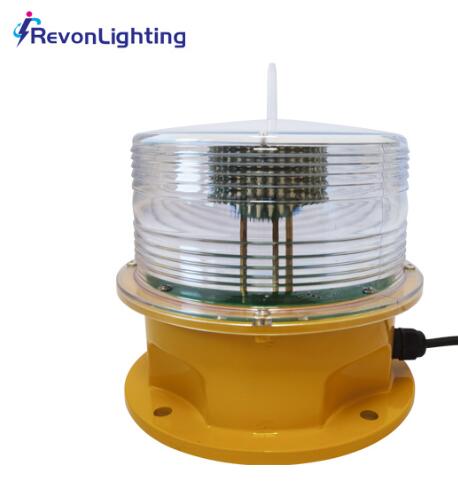Posted: 2024-07-28
The heliport beacon light plays a pivotal role in ensuring the safety and efficiency of helicopter operations. As helicopters are increasingly used for various critical missions such as emergency medical services, law enforcement, military operations, and commercial transportation, the need for reliable navigation aids becomes more significant. The heliport beacon light, a high-intensity light fixture designed to mark the location of a heliport, provides essential visual guidance for pilots, particularly during night-time operations or adverse weather conditions.
The Importance of Heliport Beacon Lights
Heliport beacon lights serve as crucial visual cues that help pilots identify and locate heliports from a distance. These lights are typically installed at elevated positions to ensure maximum visibility, emitting a bright, flashing light that can be seen from several miles away. This functionality is especially important during night operations and in low-visibility conditions such as fog, rain, or snow.
Enhanced Visibility: The primary function of the heliport beacon light is to enhance the visibility of the heliport. By providing a bright and easily identifiable signal, these lights help pilots navigate safely to the landing area, reducing the risk of accidents.
Safety and Navigation: Heliport beacon lights are essential for safe navigation. They provide a clear reference point, allowing pilots to maintain their bearings and approach the heliport with confidence. This is particularly important in complex urban environments or remote areas where other visual cues might be scarce.

Compliance with Aviation Standards: The installation of heliport beacon lights is often mandated by aviation authorities such as the International Civil Aviation Organization (ICAO) and the Federal Aviation Administration (FAA). Compliance with these regulations ensures that heliports meet the necessary safety standards, contributing to overall aviation safety.
Components and Features of Heliport Beacon Lights
Modern heliport beacon lights are designed with several advanced features to enhance their functionality and reliability. Key components and characteristics include:
High-Intensity LEDs: Many heliport beacon lights utilize high-intensity LED technology, which provides superior brightness and visibility. LEDs are also energy-efficient and have a longer lifespan compared to traditional lighting technologies, reducing maintenance costs and operational downtime.
Weather Resistance: Heliport beacon lights are built to withstand harsh environmental conditions. They are typically housed in weather-resistant enclosures that protect the internal components from rain, snow, dust, and extreme temperatures. This durability ensures reliable performance in various climates and conditions.
Flash Patterns and Colors: To enhance visibility and comply with regulatory standards, heliport beacon lights often feature specific flash patterns and colors. These patterns can be adjusted based on operational requirements and environmental conditions. Common colors include white and green, each serving specific purposes based on aviation guidelines.
Solar Power Options: In remote or off-grid locations, heliport beacon lights may be equipped with solar panels to provide a sustainable power source. Solar-powered beacons reduce dependency on external power infrastructure and offer a reliable lighting solution in areas with limited access to electricity.
Applications of Heliport Beacon Lights
Heliport beacon lights are used in a variety of settings to support safe and efficient helicopter operations. Some of the key applications include:
Medical and Emergency Services: Hospitals and emergency medical facilities often have helipads equipped with beacon lights to facilitate rapid and safe landings for medical helicopters. This is crucial for timely patient transport and emergency response.
| Heliport Beacon Light | erg |
| wrtg | eb |
Military and Law Enforcement: Military bases and law enforcement agencies use heliport beacon lights to ensure the safe operation of helicopters during tactical missions, search and rescue operations, and other critical activities. The beacon lights provide clear visual cues for pilots operating in challenging conditions.
Commercial and Private Heliports: Commercial and private heliports utilize beacon lights to guide pilots to their landing areas. These lights are essential for ensuring the safety of passengers and crew, as well as for maintaining efficient helicopter operations.
Remote and Offshore Locations: In remote areas, such as oil rigs and research stations, heliport beacon lights are vital for safe helicopter landings. These locations often lack other navigational aids, making beacon lights essential for guiding pilots to their destinations.
Technological Advancements and Future Trends
Advancements in technology continue to improve the performance and capabilities of heliport beacon lights. Innovations such as smart lighting systems, which can be remotely monitored and controlled, offer enhanced operational flexibility. These systems can adjust light intensity and flash patterns based on real-time environmental conditions, ensuring optimal visibility and safety.
Furthermore, the integration of GPS and other navigational technologies with heliport beacon lights can provide additional layers of guidance for pilots. This can be particularly useful in complex environments where multiple navigational aids are required to ensure safe landings.
Conclusion
The heliport beacon light is an indispensable tool in modern helicopter operations, providing essential visual guidance and enhancing safety. By ensuring that heliports are easily identifiable from a distance, these lights play a critical role in preventing accidents and ensuring the efficient flow of helicopter traffic. As technology continues to evolve, the functionality and reliability of heliport beacon lights will only improve, further contributing to the safety and effectiveness of helicopter operations worldwide. Investing in high-quality heliport beacon lights is a crucial step toward maintaining the highest standards of aviation safety and operational efficiency.